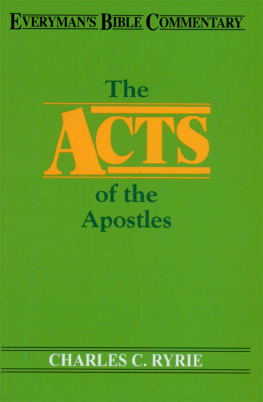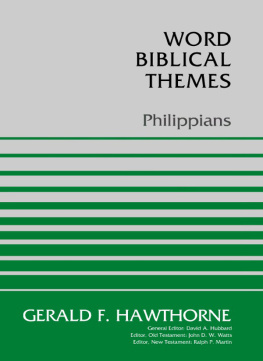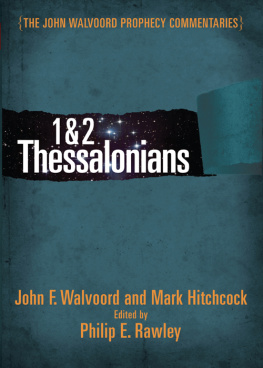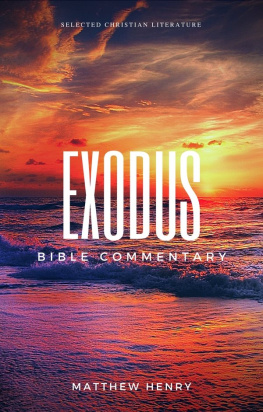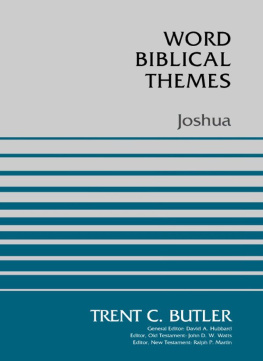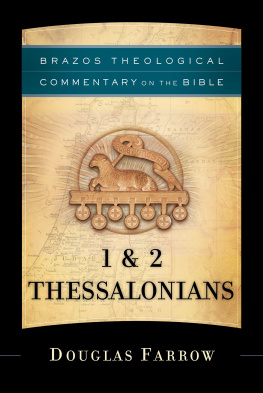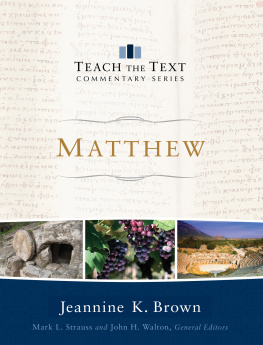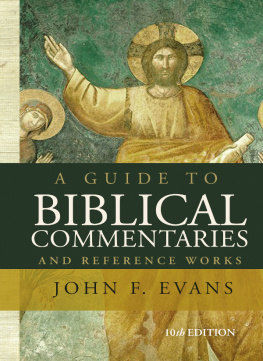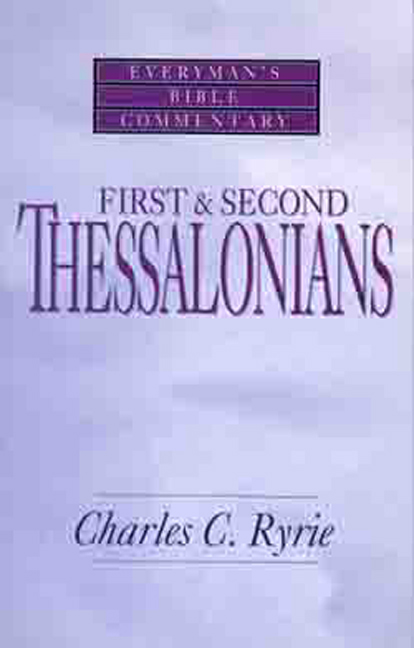
Charles C. Ryrie

M OODY P RESS
CHICAGO
1959, 1987, 2001 by
C HARLES C. R YRIE
All rights reserved. No part of this book may be reproduced in any form without permission in writing from the publisher except in the case of brief quotations embodied in critical articles or reviews.
All Scripture quotations, unless otherwise specified, are taken from the New American Standard Bible, Copyright The Lockman Foundation 1960, 1962, 1963, 1968, 1971, 1972, 1973, 1975, 1977, and 1995. Used by permission.
Scripture quotations marked KJV are taken from the King James Version.
Scripture quotations marked NIV are taken from the Holy Bible: New International Version. NIV. Copyright 1973, 1978, 1984 by International Bible Society. Used by permission of Zondervan Publishing House. All rights reserved.
Scripture quotations marked RSV are taken from the Revised Standard Version of the Bible 1946, 1952, 1971 by the Division of Christian Education of the National Council of Churches of Christ in the USA. Used by permission. All rights reserved.
Scripture quotations marked NKJV are taken from the New King James Version. Copyright 1982 by Thomas Nelson, Inc. Used by permission. All rights reserved.
Library of Congress Cataloging-in-Publication Data
Ryrie, Charles Caldwell, 1925
First and Second Thessalonians / Charles Caldwell Ryrie.
p. cm. -- (Everymans Bible commentary)
Includes bibliographical references.
ISBN 0-8024-7110-2
1. Bible. N.T. Thessalonians--Commentaries. I. Title. II. Series.
BS2725.3 .R97 2001
227.8107--dc21
00-046922
1 3 5 7 9 10 8 6 4 2
Printed in the United States of America

CONTENTS

S ECTION 1:
P AUL S T HANKSGIVING FOR AND C OMMENDATION OF THE T HESSALONIANS , 1:110
S ECTION 2:
P AUL S C ONDUCT A MONG THE T HESSALONIANS , 2:112
S ECTION 3:
P AUL S C ONCERN FOR THE T HESSALONIANS , 2:133:13
S ECTION 4:
I NSTRUCTIONS AND E XHORTATIONS , 4:15:28
S ECTION 1:
E NCOURAGEMENT IN P ERSECUTION , 1:312
S ECTION 2:
E NCOURAGEMENT FROM P ROPHECY , 2:117
S ECTION 3:
E NCOURAGEMENT AND C OMMANDS
C ONCERNING V ARIOUS P RACTICES , 3:118

BACKGROUND OF THE
THESSALONIAN LETTERS

E very once in a while a new book will appear on the market with a title something like this: How Ive Changed My Mind. The various chapters then detail the ways in which the authors thinking has changed (often about important doctrines) throughout his lifetime. The apostle Paul would never have written such a book. Heres why we can be certain of that.
Although among the earliest of Pauls letters (only Galatians is earlier), 1 and 2 Thessalonians in no way exhibit undeveloped or immature thinking. Paul had been a Christian for seventeen or eighteen years by the time he wrote 1 Thessalonians. Furthermore, he had been a missionary for seven or eight years and had written Galatians, a letter filled with meaty and important doctrines. His theology was fully developed in his mind and tested in his ministry before he wrote these letters to the Thessalonians.
These epistles are like finely cut gems. They reflect the depths of theological thought, especially in the area of future things. They mirror the pattern of teaching that the apostle used with new Gentile converts. From every part shine forth the character and conduct of Pauls missionary heart, and they sparkle with the brilliance of the captivating power of the Gospel of the grace of Christ. They are a joy to read and a delight to study.
T HE B EGINNING OF P AUL S S ECOND M ISSIONARY T RIP , A CTS 15:3617:9
1. The purpose of the trip, 15:36. Not to evangelize but to revisit the churches established on the first journey to see how they were faring was the purpose of the second trip.
2. The sharp disagreement, 15:3741. Pauls unwillingness to take John Mark along, because he had deserted the team partway through the first trip, and Barnabass insistence that they include Mark provoked a sharp disagreement between the two leaders. The outcome saw two teams going out in different directions: Paul and Silas, and Barnabas and Mark.
3. The addition of Timothy, 16:15. When Paul and Silas came to Lystra, they added Timothy to the team.
4. The call to go to Europe, 16:610. Having come from the east, the group was forbidden to go west into Asia Minor and north into Bithynia. So they traveled in a northwesterly direction around Asia Minor, arriving eventually at Troas. There they waited for the Lords leading and received it in the form of a vision of a Greek man (who represented the finest of intelligent, civilized, and cultured humanity of that day) calling them to Greece in Europe.
5. The ministry in Philippi, 16:1140. This included the conversion of Lydia and her associates, the exorcism of a demonpossessed girl, being imprisoned, released by an earthquake, and the conversion of the jailers household.
6. The ministry in Thessalonica, 17:19.
T HE C ITY OF T HESSALONICA
I TS H ISTORY
In Pauls day, Thessalonica (now Salonika) was an important city. Its history had made it so, for in 315 B.C. , Cassander, son of Antipater, reconstructed Therma (named for its hot springs) into a fine metropolis and gave it the name Thessalonica after his wife, who was the daughter of Philip of Macedon and half sister of Alexander. Under the Romans, the city was the capital of the newly formed province and its largest city. It had a population of about 200,000 (around 300,000 today).
I TS L OCATION
Thessalonicas strategic location also contributed to its importance. It was one of the greatest, if not the greatest, of the cities along the entire Egnatian Road, a great military highway that connected Rome with the east and ran parallel to the sea line of communication by way of Corinth. Situated at the north-western corner of the Aegean Sea, its sheltered harbor was made into a naval station and equipped with docks by the Romans. Its location midway between the Adriatic and the Hellespont makes it even today a natural outlet for traffic from all points.
This commercial activity had two important results. First, it made Thessalonica a wealthy city. Well-to-do Romans settled there, and Jewish merchants were attracted by the commercial advantages of the city (Acts 17:4), although the majority of people made their living by manual labor. Women in Macedonia enjoyed a higher social position and greater privileges than elsewhere in the civilized world. Second, the citys commercial activity brought Thessalonica a reputation for evil and licentiousness. The strange mixtures of a seaport city and the rites of the various cults in the city necessitated a special appeal on the part of the apostle for chaste living (1 Thess. 4:18).




